Unlucky number: what really happened to Apollo 13
17th Jun 2022
On 16th July 1969, American astronaut Neil Armstrong set foot on the lunar surface for the first time in human history. This event shocked the whole world and made millions of people dream about space. Over the next five years, the USA landed on the moon five more times, which finally secured the United States’ leadership in the big space race with the USSR.
However, this great victory came at a great price. NASA’s Apollo program not only proved to be a failure in terms of scientific gain, but it also ruffled the pockets of American taxpayers and had several tragic moments. During tests on the ground, the crew of Apollo 1 died due to a sudden fire. And the Apollo 13 disaster in space nearly claimed the lives of three more astronauts. Has NASA been able to cope with the space challenge? What happened to Apollo 13 mission? Let’s find out.
Trouble on the Ground: what happened to Apollo 13 crew in the pre-flight phase
Apollo 13 was the seventh manned mission of the Apollo program and the third one to carry astronauts to the surface of the moon. The crew was to study the lunar crater, named after the Venetian cartographer Fra Mauro. It is located on the visible side of the Moon and, presumably, was created by ejection or rock fragments formed as a result of a collision with a large meteorite.
It would seem that the seventh mission was not very hazardous, but the problems began long before the start.
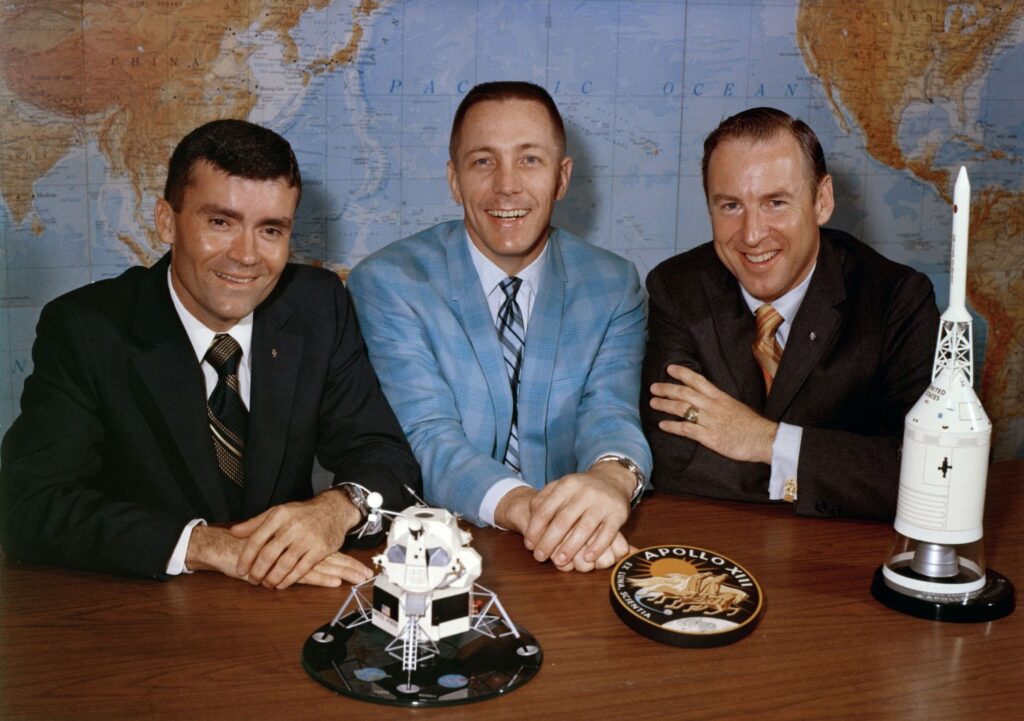
Initially, the Alan Shepard team was preparing for the flight, but they were replaced. What happened to the crew of Apollo 13? Dick Slayton, NASA’s director of flight operations, decided that Shepard needed more time to prepare for the mission, as he had a 9-year hiatus from flying and had just recently undergone surgery for an inner ear condition. As a result, the crew of Apollo 14 was chosen to complete the mission:
- James A. Lovell Jr. — commander,
- Thomas Kenneth «Ken» Mattingly — command module pilot,
- Fred W. Haise Jr. — lunar module pilot.
Still, this crew also faced some challenges. Seven days before launch, Apollo 13 lunar module pilot Charles Duke contracted measles from his son’s friend. Members of the main and reserve crews were in contact with each other, but of the remaining five, only Ken Mattingly, according to doctors, had a risk of contracting the disease. Usually, if any member of the main crew fell out, this entire crew was replaced by a backup one, but Duke’s illness ruled this option out. Mattingly was eventually removed from the flight two days before launch, despite the protests of his friend James Lovell, and John “Jack” L. Swigert Jr, the reserve crew’s command module pilot, took his place. Still, Mattingly played a big role in saving his crew by assisting the Houston ground team.
What happened to the Apollo 13 rocket
On 11th April 1970, at 0600 UTC, a Saturn V heavy launch vehicle successfully lifted off from LC 39 Kennedy Space Center to send Apollo 13 to the Moon. Over 100 thousand people at the spaceport and its surrounding area have watched the rocket launch. For the first 5 and a half minutes, the flight went normally, but then suddenly, the central engine of the second stage turned off 2 minutes ahead of schedule. Since the rocket had already gained sufficient acceleration, the flight was not interrupted, and the lack of thrust was compensated by extending the operation of 4 side engines by an extra 34 seconds.
Post-flight analysis showed that the failure of the 5th engine of the Saturn V’s second stage resulted from low-frequency pressure fluctuations in the combustion chamber, due to which the pressure in the chamber dropped and the fuel automatics cut off the fuel supply. A few seconds separated the rocket from a possible crash.
The Apollo 13 disaster date
The number 13 in the name of Apollo was not the only “bad luck sign” of this mission. On the evening of 13th April, the third day of the flight, the astronauts reported the first explosion on the carrier.
Up to this point, the mission had proceeded normally. After the vehicle entered the waiting orbit, the astronauts took off their flight suits and started checking the systems. At 03:06:39, the ship’s main module, including the Odyssey command module and service module, separated from the third stage, and Jack Swigert began maneuvers to remove the Aquarius lunar module from it.
At 03:40:50, the crew, using the service module engine, performed the first correction, which transferred the vehicle to a “hybrid” trajectory, allowing Aquarius to land on the moon at a given point, in the area of the Fra Mauro crater. The next correction was necessary only during Apollo’s return to Earth.
At the 47th hour of the flight, the astronauts rested after sleep, had to perform the destratification procedure (cryogenic mixing in oxygen and hydrogen tanks in the service module). This was required in order to bring the readings of the level sensors back to normal since due to the stratification of oxygen and hydrogen under the influence of weightlessness, the sensors could give incorrect values.
The oxygen level sensor in tank No.2 was already going off the scale by that time, but the readings of the pressure and temperature sensors were normal, so the situation at the MCC was recognized as not critical and it was decided to perform mixing after broadcasting to Earth, which the crew was supposed to conduct for viewers to acquaint them with his life on the ship. As a result, John Swigert started destratification at the 56th hour into the flight. After 16 seconds, a loud bang followed, and the vehicle shook violently.
Houston, we had a problem: what happened to Apollo 13 service module
The sound was caused by the explosion of oxygen tank No. 2, the one whose level sensor went off the scale. As a result, two of the three existing fuel cell batteries were damaged, which deprived the compartment of the Odyssey command module of power supply, and the crew of the opportunity to land on the moon. However, the trouble was only getting started. The crew now had to fight to save their lives as the remaining oxygen levels started dropping steadily.
Why did oxygen tank 2 explode?
Oxygen Tank No. 2 was originally installed on the Apollo 10 Service Module. Before the Apollo 10 launch, the tank was removed from the service module for maintenance and accidentally dropped from a height of about two inches. As a result, Apollo 10 flew with another tank, and this one was installed on Apollo 13 since the inspection did not find any damage. Before the Apollo 13 flight, the tank was re-tested and bake-in to expel any remaining oxygen from it. It was this process that severely damaged the Teflon insulation of the tank’s internal electrical wiring, according to NASA’s report.
When Jack Swigert performed his planned cryo-stirring, a spark from a damaged wire ignited a piece of insulation. The Teflon quickly burned out in the oxygen-rich environment, causing an almost instantaneous pressure surge and the tank exploded.
Apollo 13 Rescue scenarios
After futile attempts to stop the oxygen leak, Mission Control decided to use the Odyssey blackout scenario, and the crew transferred to Aquarius for the duration of their flight to Earth.
An analysis of all the spacecraft systems showed that, under certain conditions, the crew has a high chance of returning. NASA Emergency Rescue Headquarters has developed five scenarios to bring Apollo 13 back to Earth. Three were excluded due to the high danger to the crew’s lives, and the fourth one — because of the rescue operation complexity. As a result, NASA decided to switch on the landing stage engine, with a flyby of the Moon, twice. The crew was supposed to splash down in the Pacific Ocean, in an area convenient for rescue, but the flight would take 142 hours, which is 9 hours longer than scenario No.4.
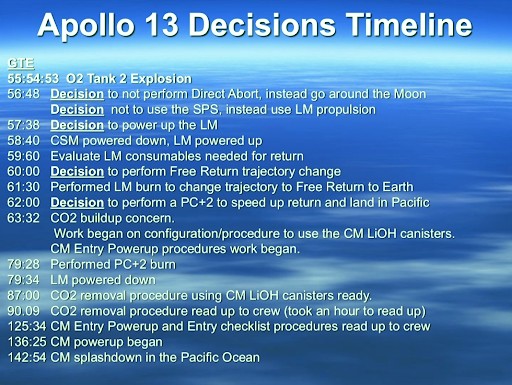
What happened to Apollo 13 astronauts on the way home
All major rescue decisions were made within six hours of the explosion. The space and ground crews had six more days to go before Apollo 13 circled the Moon and returned home. And this wasn’t easy.
CO2 hazard
The Aquarius environmental systems were not designed to filter the air for three astronauts for several days, so on 15th April, at about the 85th hour of flight, the lunar module CO2 absorber cartridges could no longer cope and the pressure of carbon dioxide in the atmosphere of the lunar module cabin reached 13mm Hg. Art. at a standard rate of 2-3. What would have happened to the Apollo 13 crew if the CO2 level had continued to rise? A pressure of 15mm meant the poisoning of the entire crew with a fatal outcome. To fix the problem, it was necessary to replace the CO2 absorber cartridges with cartridges from the command module. But the command module cartridges were square and could not fit into the lunar module’s round cartridge slots.
The crew had to find a solution using only the materials available on board. As a result, engineers on Earth built a kind of adapter from parts of a space suit, cardboard, and electrical tape and sent its scheme to the astronauts. It worked!
Cold and dehydration
As power shortages prevented the use of electric heaters, the temperature in the LEM cab gradually dropped to 11 degrees Celsius. Condensation appeared and it became damp. There were no warm clothes and the team started to freeze. In addition, the astronauts needed to conserve water, as their resources were limited. Cold, lack of water, and constant stress affected the quality and the duration of sleep. The team was exhausted, and Haise developed a fever and pain when urinating. Despite this, he persevered and tried to work on an equal footing with the others.
Explosion in the LEM battery compartment
April 15th at 23:10 another explosion sounded, shaking the ship. Fred Haise looked out the window and saw fog streaming from the lunar module lander. Engineers on Earth immediately analysed the telemetry and concluded that the situation posed no threat.
What happened to Apollo 13 Aquarius? In the battery compartment, the accumulated mixture of oxygen and hydrogen ignited and burst out. One battery was lost, but the three remaining ones compensate for the power.
Loading up the Odyssey to the required mass
The command module computer was programmed for a well-defined landing weight, which included 100 pounds of lunar soil samples. Since Apollo 13 did not land the moon, the lack of mass had to be compensated for. While Swigert was busy recharging Odyssey’s batteries, Lovell and Haise moved the items, according to the list compiled by the Mission Control Center, from the lunar module to the command and placed them in the sample bays. The list included several cameras, film, oxygen hoses, and a recorder.
Trajectory correction problems
For the ship to successfully enter the Earth’s atmosphere and land at the given coordinates, the astronauts needed to correct the trajectory several times. After the 4th correction, ground-based measurements showed that the angle of the spacecraft’s entry into the atmosphere is close to optimal. However, for some unknown reason, it began to slowly decrease, which could lead to the vehicle ricocheting from the atmosphere. Another correction was necessary to deal with the situation. But the landing stage engine, which could give the ship the necessary impulse, could no longer be started, so the lunar module orientation system engines had to be used, which could take half a minute and almost completely consume their working fluid (fuel resource).
The correction was made on 17th April at 12:52:51. Orientation thrusters worked for 22 seconds. Calculations showed that the ship would splash down in an acceptable area.
Jettison of Service and Lunar modules
The next step for the team was to undock the service module, then transfer to the Odyssey and undock the Aquarius. The task was complicated by accumulated fatigue and fear that the explosion could damage the pyrobolts holding the modules together. Swigert was afraid that he might confuse the module firing buttons, located next to each other, and, out of habit, shoot the lunar module (as in a regular flight), instead of the service one. To avoid a mistake, he taped over an unnecessary button and asked Haise to keep watch over him.
After successfully firing off the service module, the astronauts were finally able to see the extent of its damage. The image was horrific. The module has been completely disabled.
Explosion in the LEM battery compartment
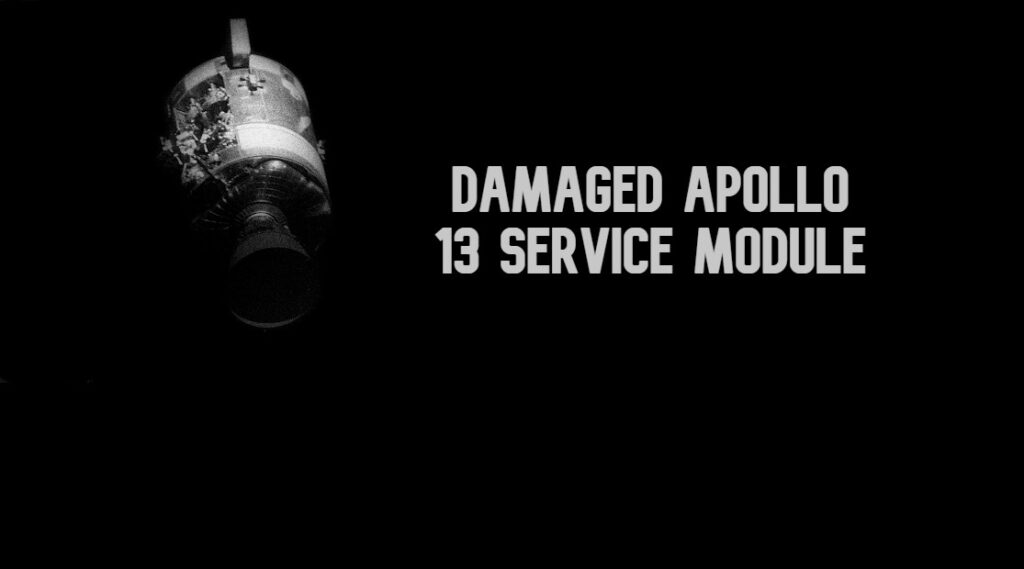
Next, the astronauts moved to the command module, battened down the hatches, and turned on the life support system. At this point, the system showed a high level of oxygen consumption, which could indicate a leak in the hatch. However, the real cause was the pressure difference between Aquarius and Odyssey, so the latter began to raise it to the standard level. Once this level was reached, oxygen consumption returned to normal. Swigert blew up the docking bolts and the modules gently undocked.
What happened to Apollo 13 lunar module after Jettison? Aquarius went into an eternal space drift. After undocking, it still had oxygen supplies for 124 hours, electricity for 4.5 hours, and 13 litres of water.
Salvation
On 17th April at 17:53:45, the Apollo 13 crew compartment entered the Earth’s atmosphere, got in touch with the command centre at 17:58:25, and at 18:07:41, it safely splashed down 7.5 kilometres from the landing ship Iwo Jima. All members of the Apollo 13 crew were airlifted to Honolulu, Hawaii. For their courage and high professionalism, the astronauts and employees of the Houston Mission Control Centre were awarded the highest civilian award in the United States — the Medal of Freedom.
The Apollo 13 disaster in a movie
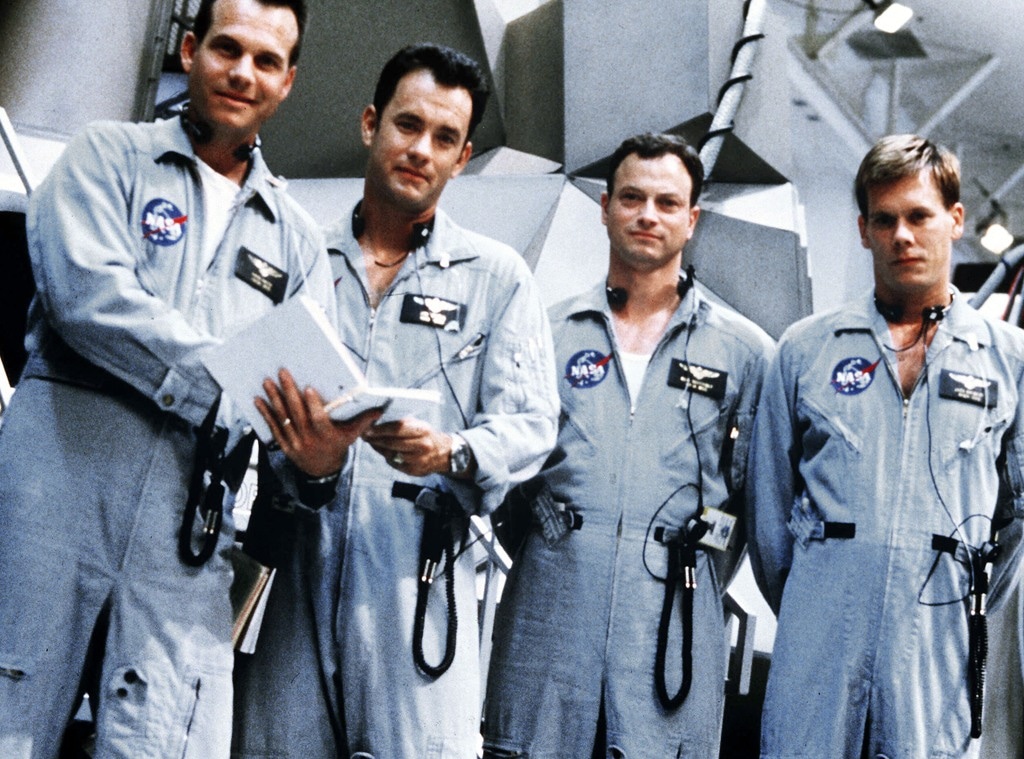
In 1995, Hollywood director Ron Howard made a feature movie based on the story of Apollo 13. The astronaut roles were performed by:
- Tom Hanks – James Lovell,
- Kevin Bacon – Jack Swigert,
- Bill Paxton – Fred Haise,
- Gary Sinise – Ken Mattingly.
Interestingly, James Lovell himself also starred in one of the scenes: in the film finale, he, in the form of one of the officers on the deck of the Iwo Jima ship, shakes hands with Tom Hanks, who plays Lovell. The movie reproduces what happened to the Apollo 13 crew quite accurately, so it is worth watching.
Apollo 13 mission timeline
- 000:00:00 Launched April 11, 1970, at 13:13 Houston time.
- 000:12:30 Entering the waiting orbit.
- 002:35:46 Entering the flight path to the Moon.
- 003:06:39 Separation of the third stage and the main block of Apollo 13.
- 003:19:09 Docking of the command module with the lunar module and removal of the lunar module from the third stage shell.
- 030:40:50 First trajectory correction with the service module engine.
- 055:54:53 The explosion of oxygen tank No.2.
- 061:29:43 The second trajectory correction using the lunar module landing stage engine. This correction provided a transition from a hybrid orbit to the orbit of free return to the Earth.
- 077:02:39 The beginning of the vehicle flight behind the lunar disk. Loss of radio communication.
- 077:21:18 The resumption of radio communications.
- 079:27:39 Third correction. An accelerating impulse that made it possible to shorten the flight time from the Moon to the Earth.
- 097:13:14 Emission of gases accumulated in the battery compartment of the lunar module.
- 105:18:28 Fourth trajectory correction.
- 137:01:48 Fifth trajectory correction.
- 138:01:48 Undocking a service module.
- 141:30:00 Undocking the lunar module.
- 142:40:46 Activation of all command module landing systems and pre-landing navigation.
- 142:42:42 Entry into the atmosphere.
- 142:54:41 Splashdown. Friday, April 17, 1970, at 12:07 pm Houston time.
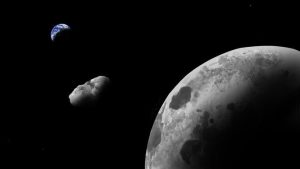
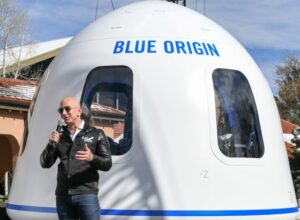




Thank you for your comment! It will be visible on the site after moderation.